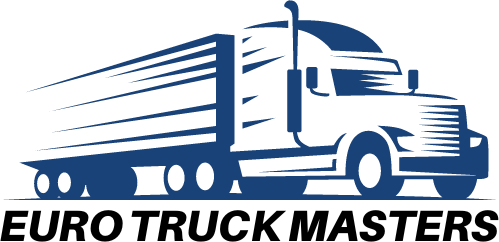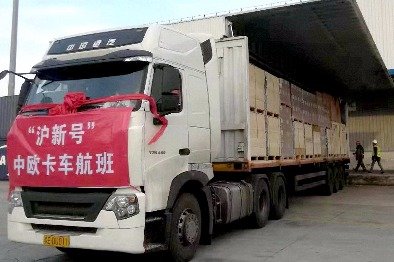A truck loaded with high-tech equipment from Germany is unloaded in Shanghai on Saturday. (Photo provided by China Daily)
Flexibility, cost advantage and ability to handle high volumes drive demand.
Truck shipments between China and Europe are set to surge after a vehicle loaded with high-tech manufacturing equipment successfully completed an 11,000-kilometre road trip from Dornstadt in Germany to Shanghai in two weeks.
The truck loaded with goods crossed Germany, Poland, Belarus, Russia and Kazakhstan before entering China on the final leg of its journey. It was also the first cargo truck from Europe to Shanghai carried out by Suzhou-based logistics company Suzhou Daoxin Supply Chain Management Co Ltd.
In February, the international trade company of Shanghai Lishun Electronics Science and Technology Co., Ltd. co-founder Xiong Desun received an order for such equipment from a German company in Minhang District. However, due to bad weather conditions, the company was unable to use air freight to ship the products within two weeks.
“When we learned that the goods could be transported by road within two weeks, we immediately decided to use this option,” Xiong said. The truck carrying the advanced technological equipment completed customs clearance in Khorgas in the Xinjiang Uygur Autonomous Region and arrived in Shanghai on schedule.
“I never imagined that the customs clearance process would only take two to three hours. This is much shorter compared to our previous experience which took at least two to three days,” Xiong said.
According to him, although air travel is faster, freight takes longer to clear customs and transit. “In addition, we saved 42 percent of our delivery costs by using land transportation. So we will use trucking as much as possible in the future,” Xiong said. Up to 90 percent of the company’s cargo was previously shipped by air, as the products are high-value and sensitive.
Another reason for using air transport was strict security and time constraints. Rail transport was not feasible because it required a full train loaded with goods to make it economically viable. In addition, the goods had to be sent to the railway station first, then transported by road to the final destination, Xiong said.
According to estimates by the International Road Transport Union, road transport can save up to 10 days compared to rail, and its costs are much lower than air transport.
He Rong Yi, general manager of Suzhou Daoxin, was one of the first people to spot the opportunities in land transport between Europe and China.
The cross-border logistics company has seen growing demand for trade between China and countries and regions related to the Belt and Road Initiative in recent years, Hu said.
After some visits by staff along the truck route, Suzhou Daoxin delivered the first batch of goods, a truck of steel coils from Stuttgart, Germany to Suzhou, Jiangsu Province in March 2018. However, the trial transportation was unsatisfactory as it took 21 days.
“We tried more and finally managed to deliver the goods within 12 to 13 days in late August,” he said. Currently, Suzhou Daoxin operates trucking services between Europe and Chinese cities every week.
He said that after the transportation service has been running for more than six months, there are still many things to be done to improve the 10,000-kilometer journey, especially in terms of infrastructure.
“My hope is that more companies will join this game, because the more investment directed to this sector, the better results we can achieve for the entire industry,” he said.
Alblas Transport (Xinjiang) Co Ltd is another company that operates land transportation services across Eurasia. Currently, a truck loaded with goods is heading from Foshan, Guangzhou Province to Alicante, Spain.
“I expect the 13,500-kilometer route to take about 18 days to complete, and the alternative transportation method has received positive response from our customers,” said Dilxat Mamat, COO of Alplus Transportation (Xinjiang).
The delivery of the Foshan to Spain marks the launch of trucking services from China to Europe on a weekly basis after two successful trials last November and February.
“The cost of land transport is less than 30 percent of the cost of air transport, and it also saves the time required to travel between airports and the final destination,” Mamat added.
The power of trucking is evident when compared to sea transport, which typically takes between 45 days and two months (depending on weather conditions), and goods need to be taken on and off a ship four or five times due to necessary shifts, Xiong said.
“Under the TIR Convention, we can achieve door-to-door transport, without having to open containers for inspection. This is also an advantage of TIR road transport,” he added.
TIR, or Transports Internationaux Routetiers, is the only global customs transit system for moving goods across international borders. Since its creation in 1948, it has been facilitating international road transport and promoting trade development. TIR, which has 76 contracting parties, is governed by the United Nations TIR Convention and administered by the Swiss-based IRU (International Road Transport Union). China has been a member of TIR since 2016.
“In terms of efficiency, road transport saves up to 50 percent of costs compared to air transport, and the delivery time is at least 10 days compared to railway. The high flexibility of road transport can ensure door-to-door services, which is suitable for high-priced goods and customers with strict time requirements. In addition, it can also solve the problem of bulk cargo shipping,” said Zhou Yan, deputy chief representative for East and Southeast Asia at the International Transport Association.
According to Zhou, there is great potential for land transportation across Eurasia. First, the EU is China’s largest trading partner and largest source of imports, and under the Belt and Road Initiative, bilateral trade volume is increasing steadily.
In 2018, the total trade volume between China and the EU reached 4.5 trillion yuan ($669.1 billion), up 7.9 percent year on year, according to data from the General Administration of Customs.
Moreover, major markets along the Silk Road Economic Belt and all EU countries are members of the TIR system. With the implementation and improvement of the TIR system in China, road transport as a cross-border tool will play a greater role in trade flows.
“Under the current international situation, the Belt and Road Initiative has gained more influence. Given the huge trade volume between China and Europe, trucking provides an alternative option besides air, sea and railway transportation. It will also bring more development opportunities to countries and regions linked by the Belt and Road Initiative,” Zhou said.





